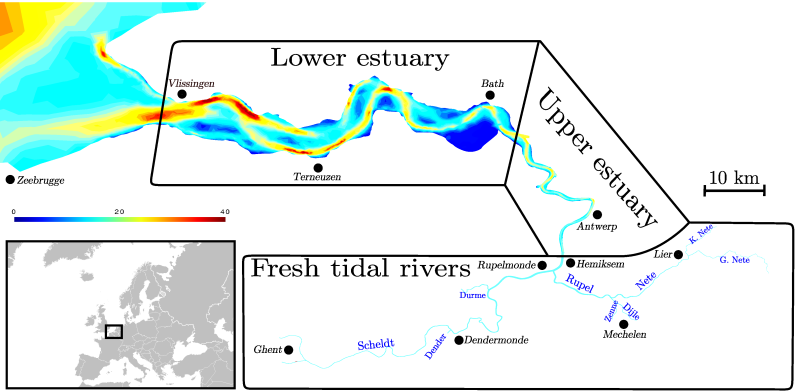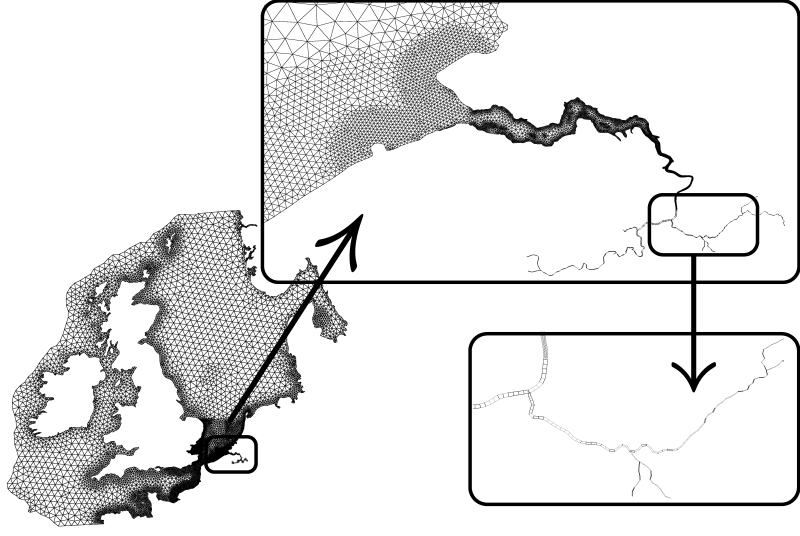The Scheldt basin, located in Northern France, Belgium and the Netherlands, represents an extreme case of water pollution due to the high population density (over 500 inhabitants per square kilometer), active industrial development and its intensive agriculture and animal farming.
As the Scheldt Estuary is generally well-mixed with little or no vertical structure and small salinity gradients due to a small residual flow, a depth averaged 2D model is therefore sufficient for capturing the dominant dynamics. The width of the estuary ranges from 8km near the mouth (at Vlissingen) to 1.5km near the Dutch/Belgian border narrowing down to 50 meters in Ghent. As it is fairly impractical to use a 2D model on such narrow channels, the rivers upstream of Hemiksem are described with a 1D model.
SLIM can simulate the barotropic flow in the North Sea and then the propagation of the tidal signal in the estuary and the in the branching river network. By using a wetting and drying algorithm, we can explicitly represent emerging sandbanks at low tide (shown in black). The model has been further used to simulate the transport of fecal bacteria, sediments and radioactive tracers in this multi-scale domain.
VIDEO
External collaborators
Prof. Eric Delhez (University of Liège)
To learn more…
778265
scheldt
1
apa
50
date
desc
1263
https://www.slim-ocean.be/wp-content/plugins/zotpress/
%7B%22status%22%3A%22success%22%2C%22updateneeded%22%3Afalse%2C%22instance%22%3Afalse%2C%22meta%22%3A%7B%22request_last%22%3A0%2C%22request_next%22%3A0%2C%22used_cache%22%3Atrue%7D%2C%22data%22%3A%5B%7B%22key%22%3A%22DIJTQIIB%22%2C%22library%22%3A%7B%22id%22%3A778265%7D%2C%22meta%22%3A%7B%22creatorSummary%22%3A%22Naithani%20et%20al.%22%2C%22parsedDate%22%3A%222016%22%2C%22numChildren%22%3A2%7D%2C%22bib%22%3A%22%26lt%3Bdiv%20class%3D%26quot%3Bcsl-bib-body%26quot%3B%20style%3D%26quot%3Bline-height%3A%202%3B%20padding-left%3A%201em%3B%20text-indent%3A-1em%3B%26quot%3B%26gt%3B%5Cn%20%20%26lt%3Bdiv%20class%3D%26quot%3Bcsl-entry%26quot%3B%26gt%3BNaithani%2C%20J.%2C%20de%20Brye%2C%20B.%2C%20Buyze%2C%20E.%2C%20Vyverman%2C%20W.%2C%20Legat%2C%20V.%2C%20%26amp%3B%20Deleersnijder%2C%20E.%20%282016%29.%20An%20ecological%20model%20for%20the%20Scheldt%20estuary%20and%20tidal%20rivers%20ecosystem%3A%20spatial%20and%20temporal%20variability%20of%20plankton.%20%26lt%3Bi%26gt%3BHydrobiologia%26lt%3B%5C%2Fi%26gt%3B%2C%20%26lt%3Bi%26gt%3B775%26lt%3B%5C%2Fi%26gt%3B%281%29%2C%2051%26%23x2013%3B67.%20%26lt%3Ba%20class%3D%26%23039%3Bzp-DOIURL%26%23039%3B%20href%3D%26%23039%3Bhttps%3A%5C%2F%5C%2Fdoi.org%5C%2F10.1007%5C%2Fs10750-016-2710-1%26%23039%3B%26gt%3Bhttps%3A%5C%2F%5C%2Fdoi.org%5C%2F10.1007%5C%2Fs10750-016-2710-1%26lt%3B%5C%2Fa%26gt%3B%26lt%3B%5C%2Fdiv%26gt%3B%5Cn%26lt%3B%5C%2Fdiv%26gt%3B%22%2C%22data%22%3A%7B%22itemType%22%3A%22journalArticle%22%2C%22title%22%3A%22An%20ecological%20model%20for%20the%20Scheldt%20estuary%20and%20tidal%20rivers%20ecosystem%3A%20spatial%20and%20temporal%20variability%20of%20plankton%22%2C%22creators%22%3A%5B%7B%22creatorType%22%3A%22author%22%2C%22firstName%22%3A%22J.%22%2C%22lastName%22%3A%22Naithani%22%7D%2C%7B%22creatorType%22%3A%22author%22%2C%22firstName%22%3A%22B.%22%2C%22lastName%22%3A%22de%20Brye%22%7D%2C%7B%22creatorType%22%3A%22author%22%2C%22firstName%22%3A%22E.%22%2C%22lastName%22%3A%22Buyze%22%7D%2C%7B%22creatorType%22%3A%22author%22%2C%22firstName%22%3A%22W.%22%2C%22lastName%22%3A%22Vyverman%22%7D%2C%7B%22creatorType%22%3A%22author%22%2C%22firstName%22%3A%22V.%22%2C%22lastName%22%3A%22Legat%22%7D%2C%7B%22creatorType%22%3A%22author%22%2C%22firstName%22%3A%22E.%22%2C%22lastName%22%3A%22Deleersnijder%22%7D%5D%2C%22abstractNote%22%3A%22%22%2C%22date%22%3A%227%5C%2F2016%22%2C%22language%22%3A%22en%22%2C%22DOI%22%3A%2210.1007%5C%2Fs10750-016-2710-1%22%2C%22ISSN%22%3A%220018-8158%2C%201573-5117%22%2C%22url%22%3A%22http%3A%5C%2F%5C%2Flink.springer.com%5C%2F10.1007%5C%2Fs10750-016-2710-1%22%2C%22collections%22%3A%5B%22GJSQZPDC%22%5D%2C%22dateModified%22%3A%222018-10-21T09%3A55%3A21Z%22%7D%7D%2C%7B%22key%22%3A%22PQE9GXHZ%22%2C%22library%22%3A%7B%22id%22%3A778265%7D%2C%22meta%22%3A%7B%22creatorSummary%22%3A%22Elskens%20et%20al.%22%2C%22parsedDate%22%3A%222014%22%2C%22numChildren%22%3A2%7D%2C%22bib%22%3A%22%26lt%3Bdiv%20class%3D%26quot%3Bcsl-bib-body%26quot%3B%20style%3D%26quot%3Bline-height%3A%202%3B%20padding-left%3A%201em%3B%20text-indent%3A-1em%3B%26quot%3B%26gt%3B%5Cn%20%20%26lt%3Bdiv%20class%3D%26quot%3Bcsl-entry%26quot%3B%26gt%3BElskens%2C%20M.%2C%20Gourgue%2C%20O.%2C%20Baeyens%2C%20W.%2C%20Chou%2C%20L.%2C%20Deleersnijder%2C%20E.%2C%20Leermakers%2C%20M.%2C%20%26amp%3B%20de%20Brauwere%2C%20A.%20%282014%29.%20Modelling%20metal%20speciation%20in%20the%20Scheldt%20Estuary%3A%20Combining%20a%20flexible-resolution%20transport%20model%20with%20empirical%20functions.%20%26lt%3Bi%26gt%3BScience%20of%20The%20Total%20Environment%26lt%3B%5C%2Fi%26gt%3B%2C%20%26lt%3Bi%26gt%3B476%26%23x2013%3B477%26lt%3B%5C%2Fi%26gt%3B%2C%20346%26%23x2013%3B358.%20%26lt%3Ba%20class%3D%26%23039%3Bzp-DOIURL%26%23039%3B%20href%3D%26%23039%3Bhttps%3A%5C%2F%5C%2Fdoi.org%5C%2F10.1016%5C%2Fj.scitotenv.2013.12.047%26%23039%3B%26gt%3Bhttps%3A%5C%2F%5C%2Fdoi.org%5C%2F10.1016%5C%2Fj.scitotenv.2013.12.047%26lt%3B%5C%2Fa%26gt%3B%26lt%3B%5C%2Fdiv%26gt%3B%5Cn%26lt%3B%5C%2Fdiv%26gt%3B%22%2C%22data%22%3A%7B%22itemType%22%3A%22journalArticle%22%2C%22title%22%3A%22Modelling%20metal%20speciation%20in%20the%20Scheldt%20Estuary%3A%20Combining%20a%20flexible-resolution%20transport%20model%20with%20empirical%20functions%22%2C%22creators%22%3A%5B%7B%22creatorType%22%3A%22author%22%2C%22firstName%22%3A%22Marc%22%2C%22lastName%22%3A%22Elskens%22%7D%2C%7B%22creatorType%22%3A%22author%22%2C%22firstName%22%3A%22Olivier%22%2C%22lastName%22%3A%22Gourgue%22%7D%2C%7B%22creatorType%22%3A%22author%22%2C%22firstName%22%3A%22Willy%22%2C%22lastName%22%3A%22Baeyens%22%7D%2C%7B%22creatorType%22%3A%22author%22%2C%22firstName%22%3A%22Lei%22%2C%22lastName%22%3A%22Chou%22%7D%2C%7B%22creatorType%22%3A%22author%22%2C%22firstName%22%3A%22Eric%22%2C%22lastName%22%3A%22Deleersnijder%22%7D%2C%7B%22creatorType%22%3A%22author%22%2C%22firstName%22%3A%22Martine%22%2C%22lastName%22%3A%22Leermakers%22%7D%2C%7B%22creatorType%22%3A%22author%22%2C%22firstName%22%3A%22Anouk%22%2C%22lastName%22%3A%22de%20Brauwere%22%7D%5D%2C%22abstractNote%22%3A%22Predicting%20metal%20concentrations%20in%20surface%20waters%20is%20an%20important%20step%20in%20the%20understanding%20and%20ultimately%20the%20assessment%20of%20the%20ecological%20risk%20associated%20with%20metal%20contamination.%20In%20terms%20of%20risk%20an%20essential%20piece%20of%20information%20is%20the%20accurate%20knowledge%20of%20the%20partitioning%20of%20the%20metals%20between%20the%20dissolved%20and%20particulate%20phases%2C%20as%20the%20former%20species%20are%20generally%20regarded%20as%20the%20most%20bioavailable%20and%20thus%20harmful%20form.%20As%20a%20%5Cufb01rst%20step%20towards%20the%20understanding%20and%20prediction%20of%20metal%20speciation%20in%20the%20Scheldt%20Estuary%20%28Belgium%2C%20the%20Netherlands%29%2C%20we%20carried%20out%20a%20detailed%20analysis%20of%20a%20historical%20dataset%20covering%20the%20period%201982%5Cu20132011.%20This%20study%20reports%20on%20the%20results%20for%20two%20selected%20metals%3A%20Cu%20and%20Cd.%20Data%20analysis%20revealed%20that%20both%20the%20total%20metal%20concentration%20and%20the%20metal%20partitioning%20coef%5Cufb01cient%20%28Kd%29%20could%20be%20predicted%20using%20relatively%20simple%20empirical%20functions%20of%20environmental%20variables%20such%20as%20salinity%20and%20suspended%20particulate%20matter%20concentration%20%28SPM%29.%20The%20validity%20of%20these%20functions%20has%20been%20assessed%20by%20their%20application%20to%20salinity%20and%20SPM%20%5Cufb01elds%20simulated%20by%20the%20hydro-environmental%20model%20SLIM.%20The%20high-resolution%20total%20and%20dissolved%20metal%20concentrations%20reconstructed%20using%20this%20approach%2C%20compared%20surprisingly%20well%20with%20an%20independent%20set%20of%20validation%20measurements.%20These%20%5Cufb01rst%20results%20from%20the%20combined%20mechanistic-empirical%20model%20approach%20suggest%20that%20it%20may%20be%20an%20interesting%20tool%20for%20risk%20assessment%20studies%2C%20e.g.%20to%20help%20identify%20conditions%20associated%20with%20elevated%20%28dissolved%29%20metal%20concentrations.%22%2C%22date%22%3A%2204%5C%2F2014%22%2C%22language%22%3A%22en%22%2C%22DOI%22%3A%2210.1016%5C%2Fj.scitotenv.2013.12.047%22%2C%22ISSN%22%3A%2200489697%22%2C%22url%22%3A%22http%3A%5C%2F%5C%2Flinkinghub.elsevier.com%5C%2Fretrieve%5C%2Fpii%5C%2FS0048969713015209%22%2C%22collections%22%3A%5B%22GJSQZPDC%22%5D%2C%22dateModified%22%3A%222018-09-06T17%3A56%3A43Z%22%7D%7D%2C%7B%22key%22%3A%22GRDE4EC9%22%2C%22library%22%3A%7B%22id%22%3A778265%7D%2C%22meta%22%3A%7B%22creatorSummary%22%3A%22Delhez%20et%20al.%22%2C%22parsedDate%22%3A%222014%22%2C%22numChildren%22%3A2%7D%2C%22bib%22%3A%22%26lt%3Bdiv%20class%3D%26quot%3Bcsl-bib-body%26quot%3B%20style%3D%26quot%3Bline-height%3A%202%3B%20padding-left%3A%201em%3B%20text-indent%3A-1em%3B%26quot%3B%26gt%3B%5Cn%20%20%26lt%3Bdiv%20class%3D%26quot%3Bcsl-entry%26quot%3B%26gt%3BDelhez%2C%20%26%23xC9%3B.%20J.%20M.%2C%20de%20Brye%2C%20B.%2C%20de%20Brauwere%2C%20A.%2C%20%26amp%3B%20Deleersnijder%2C%20%26%23xC9%3B.%20%282014%29.%20Residence%20time%20vs%20influence%20time.%20%26lt%3Bi%26gt%3BJournal%20of%20Marine%20Systems%26lt%3B%5C%2Fi%26gt%3B%2C%20%26lt%3Bi%26gt%3B132%26lt%3B%5C%2Fi%26gt%3B%2C%20185%26%23x2013%3B195.%20%26lt%3Ba%20class%3D%26%23039%3Bzp-DOIURL%26%23039%3B%20href%3D%26%23039%3Bhttps%3A%5C%2F%5C%2Fdoi.org%5C%2F10.1016%5C%2Fj.jmarsys.2013.12.005%26%23039%3B%26gt%3Bhttps%3A%5C%2F%5C%2Fdoi.org%5C%2F10.1016%5C%2Fj.jmarsys.2013.12.005%26lt%3B%5C%2Fa%26gt%3B%26lt%3B%5C%2Fdiv%26gt%3B%5Cn%26lt%3B%5C%2Fdiv%26gt%3B%22%2C%22data%22%3A%7B%22itemType%22%3A%22journalArticle%22%2C%22title%22%3A%22Residence%20time%20vs%20influence%20time%22%2C%22creators%22%3A%5B%7B%22creatorType%22%3A%22author%22%2C%22firstName%22%3A%22%5Cu00c9ric%20J.M.%22%2C%22lastName%22%3A%22Delhez%22%7D%2C%7B%22creatorType%22%3A%22author%22%2C%22firstName%22%3A%22Benjamin%22%2C%22lastName%22%3A%22de%20Brye%22%7D%2C%7B%22creatorType%22%3A%22author%22%2C%22firstName%22%3A%22Anouk%22%2C%22lastName%22%3A%22de%20Brauwere%22%7D%2C%7B%22creatorType%22%3A%22author%22%2C%22firstName%22%3A%22%5Cu00c9ric%22%2C%22lastName%22%3A%22Deleersnijder%22%7D%5D%2C%22abstractNote%22%3A%22The%20concepts%20of%20age%2C%20residence%20time%2C%20exposure%20time%20and%20in%5Cufb02uence%20time%20provide%20space%20and%20time%20dependent%20quantitative%20measures%20of%20the%20rate%20at%20which%20water%20masses%20and%20pollutants%20enter%20and%5C%2For%20leave%20a%20control%20domain.%20To%20help%20avoid%20confusion%20between%20these%20concepts%2C%20this%20paper%20provides%20clear%20de%5Cufb01nitions%20of%20the%20residence%20time%20and%20the%20in%5Cufb02uence%20time.%20The%20similarities%20and%20differences%20between%20them%20are%20illustrated%20using%20both%20a%20simpli%5Cufb01ed%201D%20advection%5Cu2013diffusion%20model%20and%20a%20realistic%20two-dimensional%20model%20of%20the%20Scheldt%20Estuary%20%28Belgium%20and%20the%20Netherlands%29.%22%2C%22date%22%3A%2204%5C%2F2014%22%2C%22language%22%3A%22en%22%2C%22DOI%22%3A%2210.1016%5C%2Fj.jmarsys.2013.12.005%22%2C%22ISSN%22%3A%2209247963%22%2C%22url%22%3A%22http%3A%5C%2F%5C%2Flinkinghub.elsevier.com%5C%2Fretrieve%5C%2Fpii%5C%2FS0924796313003072%22%2C%22collections%22%3A%5B%22GJSQZPDC%22%5D%2C%22dateModified%22%3A%222018-09-06T17%3A56%3A35Z%22%7D%7D%2C%7B%22key%22%3A%222IC3I784%22%2C%22library%22%3A%7B%22id%22%3A778265%7D%2C%22meta%22%3A%7B%22creatorSummary%22%3A%22de%20Brauwere%20et%20al.%22%2C%22parsedDate%22%3A%222014%22%2C%22numChildren%22%3A2%7D%2C%22bib%22%3A%22%26lt%3Bdiv%20class%3D%26quot%3Bcsl-bib-body%26quot%3B%20style%3D%26quot%3Bline-height%3A%202%3B%20padding-left%3A%201em%3B%20text-indent%3A-1em%3B%26quot%3B%26gt%3B%5Cn%20%20%26lt%3Bdiv%20class%3D%26quot%3Bcsl-entry%26quot%3B%26gt%3Bde%20Brauwere%2C%20A.%2C%20Gourgue%2C%20O.%2C%20de%20Brye%2C%20B.%2C%20Servais%2C%20P.%2C%20Ouattara%2C%20N.%20K.%2C%20%26amp%3B%20Deleersnijder%2C%20E.%20%282014%29.%20Integrated%20modelling%20of%20faecal%20contamination%20in%20a%20densely%20populated%20river%26%23x2013%3Bsea%20continuum%20%28Scheldt%20River%20and%20Estuary%29.%20%26lt%3Bi%26gt%3BScience%20of%20The%20Total%20Environment%26lt%3B%5C%2Fi%26gt%3B%2C%20%26lt%3Bi%26gt%3B468%26%23x2013%3B469%26lt%3B%5C%2Fi%26gt%3B%2C%2031%26%23x2013%3B45.%20%26lt%3Ba%20class%3D%26%23039%3Bzp-DOIURL%26%23039%3B%20href%3D%26%23039%3Bhttps%3A%5C%2F%5C%2Fdoi.org%5C%2F10.1016%5C%2Fj.scitotenv.2013.08.019%26%23039%3B%26gt%3Bhttps%3A%5C%2F%5C%2Fdoi.org%5C%2F10.1016%5C%2Fj.scitotenv.2013.08.019%26lt%3B%5C%2Fa%26gt%3B%26lt%3B%5C%2Fdiv%26gt%3B%5Cn%26lt%3B%5C%2Fdiv%26gt%3B%22%2C%22data%22%3A%7B%22itemType%22%3A%22journalArticle%22%2C%22title%22%3A%22Integrated%20modelling%20of%20faecal%20contamination%20in%20a%20densely%20populated%20river%5Cu2013sea%20continuum%20%28Scheldt%20River%20and%20Estuary%29%22%2C%22creators%22%3A%5B%7B%22creatorType%22%3A%22author%22%2C%22firstName%22%3A%22Anouk%22%2C%22lastName%22%3A%22de%20Brauwere%22%7D%2C%7B%22creatorType%22%3A%22author%22%2C%22firstName%22%3A%22Olivier%22%2C%22lastName%22%3A%22Gourgue%22%7D%2C%7B%22creatorType%22%3A%22author%22%2C%22firstName%22%3A%22Benjamin%22%2C%22lastName%22%3A%22de%20Brye%22%7D%2C%7B%22creatorType%22%3A%22author%22%2C%22firstName%22%3A%22Pierre%22%2C%22lastName%22%3A%22Servais%22%7D%2C%7B%22creatorType%22%3A%22author%22%2C%22firstName%22%3A%22Nouho%20Koffi%22%2C%22lastName%22%3A%22Ouattara%22%7D%2C%7B%22creatorType%22%3A%22author%22%2C%22firstName%22%3A%22Eric%22%2C%22lastName%22%3A%22Deleersnijder%22%7D%5D%2C%22abstractNote%22%3A%22In%20order%20to%20simulate%20the%20long-term%20%28months%5Cu2013years%29%20median%20Escherichia%20coli%20distributions%20and%20variations%20in%20the%20tidal%20Scheldt%20River%20and%20Estuary%2C%20a%20dedicated%20module%20was%20developed%20for%20the%20Second-generation%20Louvain-la-Neuve%20Iceocean%20Model%20%28SLIM%2C%20www.climate.be%5C%2Fslim%29.%20The%20resulting%20model%20%28SLIM-EC2%29%20presents%20two%20speci%5Cufb01c%20and%20new%20features%20compared%20to%20the%20older%20SLIM-EC%20model%20version.%20The%20%5Cufb01rst%20is%20that%20the%20E.%20coli%20concentrations%20in%20the%20river%20are%20split%20in%20three%20fractions%3A%20the%20free%20E.%20coli%20in%20the%20water%20column%2C%20the%20ones%20attached%20to%20suspended%20solids%20and%20those%20present%20in%20the%20bottom%20sediments%2C%20each%20with%20their%20own%20transport%2C%20decay%20and%20settling%5Cu2013resuspension%20dynamics.%20The%20bacteria%20attached%20to%20particles%20can%20settle%20and%20survive%20on%20the%20bottom%2C%20where%20they%20can%20be%20brought%20back%20in%20the%20water%20column%20during%20resuspension%20events.%20The%20second%20new%20feature%20of%20the%20model%20is%20that%20it%20is%20coupled%20to%20the%20catchment%20model%20SENEQUE-EC%2C%20which%20thus%20provides%20upstream%20boundary%20conditions%20to%20SLIM-EC2.%20The%20result%20is%20an%20integrated%20and%20multi-scale%20model%20of%20the%20whole%20Scheldt%20drainage%20network%20from%20its%20source%20down%20to%20the%20Belgian%5C%2FDutch%20coastal%20zone.%20This%20new%20model%20reproduces%20the%20long-term%20median%20E.%20coli%20concentration%20along%20the%20Scheldt%20River%20and%20Estuary.%20An%20extensive%20sensitivity%20study%20is%20performed%20demonstrating%20the%20relative%20robustness%20of%20the%20model%20with%20respect%20to%20the%20chosen%20parameterisations.%20In%20addition%20to%20reproducing%20the%20observed%20E.%20coli%20concentrations%20in%202007%5Cu20132008%20at%20various%20stations%2C%20two%20extreme%20wastewater%20management%20scenarios%20were%20considered.%20Overall%2C%20there%20is%20no%20doubt%20that%20the%20Scheldt%20Estuary%20acts%20as%20a%20cleaning%20%5Cufb01lter%20of%20faecal%20contamination%20originating%20from%20large%20Belgian%20cities.%20As%20a%20result%2C%20at%20the%20mouth%20of%20the%20Scheldt%20Estuary%20E.%20coli%20concentration%20is%20negligible%20in%20all%20investigated%20conditions.%22%2C%22date%22%3A%2201%5C%2F2014%22%2C%22language%22%3A%22en%22%2C%22DOI%22%3A%2210.1016%5C%2Fj.scitotenv.2013.08.019%22%2C%22ISSN%22%3A%2200489697%22%2C%22url%22%3A%22http%3A%5C%2F%5C%2Flinkinghub.elsevier.com%5C%2Fretrieve%5C%2Fpii%5C%2FS0048969713009339%22%2C%22collections%22%3A%5B%22GJSQZPDC%22%5D%2C%22dateModified%22%3A%222018-10-21T09%3A49%3A37Z%22%7D%7D%2C%7B%22key%22%3A%22XI2LFZYN%22%2C%22library%22%3A%7B%22id%22%3A778265%7D%2C%22meta%22%3A%7B%22creatorSummary%22%3A%22Gourgue%20et%20al.%22%2C%22parsedDate%22%3A%222013%22%2C%22numChildren%22%3A2%7D%2C%22bib%22%3A%22%26lt%3Bdiv%20class%3D%26quot%3Bcsl-bib-body%26quot%3B%20style%3D%26quot%3Bline-height%3A%202%3B%20padding-left%3A%201em%3B%20text-indent%3A-1em%3B%26quot%3B%26gt%3B%5Cn%20%20%26lt%3Bdiv%20class%3D%26quot%3Bcsl-entry%26quot%3B%26gt%3BGourgue%2C%20O.%2C%20Baeyens%2C%20W.%2C%20Chen%2C%20M.%20S.%2C%20de%20Brauwere%2C%20A.%2C%20de%20Brye%2C%20B.%2C%20Deleersnijder%2C%20E.%2C%20Elskens%2C%20M.%2C%20%26amp%3B%20Legat%2C%20V.%20%282013%29.%20A%20depth-averaged%20two-dimensional%20sediment%20transport%20model%20for%20environmental%20studies%20in%20the%20Scheldt%20Estuary%20and%20tidal%20river%20network.%20%26lt%3Bi%26gt%3BJournal%20of%20Marine%20Systems%26lt%3B%5C%2Fi%26gt%3B%2C%20%26lt%3Bi%26gt%3B128%26lt%3B%5C%2Fi%26gt%3B%2C%2027%26%23x2013%3B39.%20%26lt%3Ba%20class%3D%26%23039%3Bzp-DOIURL%26%23039%3B%20href%3D%26%23039%3Bhttps%3A%5C%2F%5C%2Fdoi.org%5C%2F10.1016%5C%2Fj.jmarsys.2013.03.014%26%23039%3B%26gt%3Bhttps%3A%5C%2F%5C%2Fdoi.org%5C%2F10.1016%5C%2Fj.jmarsys.2013.03.014%26lt%3B%5C%2Fa%26gt%3B%26lt%3B%5C%2Fdiv%26gt%3B%5Cn%26lt%3B%5C%2Fdiv%26gt%3B%22%2C%22data%22%3A%7B%22itemType%22%3A%22journalArticle%22%2C%22title%22%3A%22A%20depth-averaged%20two-dimensional%20sediment%20transport%20model%20for%20environmental%20studies%20in%20the%20Scheldt%20Estuary%20and%20tidal%20river%20network%22%2C%22creators%22%3A%5B%7B%22creatorType%22%3A%22author%22%2C%22firstName%22%3A%22O.%22%2C%22lastName%22%3A%22Gourgue%22%7D%2C%7B%22creatorType%22%3A%22author%22%2C%22firstName%22%3A%22W.%22%2C%22lastName%22%3A%22Baeyens%22%7D%2C%7B%22creatorType%22%3A%22author%22%2C%22firstName%22%3A%22M.S.%22%2C%22lastName%22%3A%22Chen%22%7D%2C%7B%22creatorType%22%3A%22author%22%2C%22firstName%22%3A%22A.%22%2C%22lastName%22%3A%22de%20Brauwere%22%7D%2C%7B%22creatorType%22%3A%22author%22%2C%22firstName%22%3A%22B.%22%2C%22lastName%22%3A%22de%20Brye%22%7D%2C%7B%22creatorType%22%3A%22author%22%2C%22firstName%22%3A%22E.%22%2C%22lastName%22%3A%22Deleersnijder%22%7D%2C%7B%22creatorType%22%3A%22author%22%2C%22firstName%22%3A%22M.%22%2C%22lastName%22%3A%22Elskens%22%7D%2C%7B%22creatorType%22%3A%22author%22%2C%22firstName%22%3A%22V.%22%2C%22lastName%22%3A%22Legat%22%7D%5D%2C%22abstractNote%22%3A%22This%20paper%20presents%20the%20sediment%20module%20designed%20for%20the%20two-dimensional%20depth-averaged%20and%20onedimensional%20section-averaged%20components%20of%20the%20%5Cufb01nite-element%20model%20SLIM%20%28Second-generation%20Louvainla-Neuve%20Ice-ocean%20Model%29%20in%20the%20framework%20of%20its%20application%20to%20the%20tidal%20part%20of%20the%20Scheldt%20Basin.%20This%20sediment%20transport%20module%20focuses%20on%20%5Cufb01ne-grained%2C%20cohesive%20sediments.%20It%20is%20a%20necessary%20tool%20to%20undertake%20environmental%20biogeochemical%20studies%2C%20in%20which%20%5Cufb01ne%20sediment%20dynamics%20play%20a%20crucial%20role.%22%2C%22date%22%3A%2212%5C%2F2013%22%2C%22language%22%3A%22en%22%2C%22DOI%22%3A%2210.1016%5C%2Fj.jmarsys.2013.03.014%22%2C%22ISSN%22%3A%2209247963%22%2C%22url%22%3A%22http%3A%5C%2F%5C%2Flinkinghub.elsevier.com%5C%2Fretrieve%5C%2Fpii%5C%2FS0924796313000833%22%2C%22collections%22%3A%5B%22GJSQZPDC%22%5D%2C%22dateModified%22%3A%222018-10-21T11%3A11%3A43Z%22%7D%7D%2C%7B%22key%22%3A%22D54SM3PI%22%2C%22library%22%3A%7B%22id%22%3A778265%7D%2C%22meta%22%3A%7B%22creatorSummary%22%3A%22de%20Brye%20et%20al.%22%2C%22parsedDate%22%3A%222012%22%2C%22numChildren%22%3A2%7D%2C%22bib%22%3A%22%26lt%3Bdiv%20class%3D%26quot%3Bcsl-bib-body%26quot%3B%20style%3D%26quot%3Bline-height%3A%202%3B%20padding-left%3A%201em%3B%20text-indent%3A-1em%3B%26quot%3B%26gt%3B%5Cn%20%20%26lt%3Bdiv%20class%3D%26quot%3Bcsl-entry%26quot%3B%26gt%3Bde%20Brye%2C%20B.%2C%20de%20Brauwere%2C%20A.%2C%20Gourgue%2C%20O.%2C%20Delhez%2C%20E.%20J.%20M.%2C%20%26amp%3B%20Deleersnijder%2C%20E.%20%282012%29.%20Water%20renewal%20timescales%20in%20the%20Scheldt%20Estuary.%20%26lt%3Bi%26gt%3BJournal%20of%20Marine%20Systems%26lt%3B%5C%2Fi%26gt%3B%2C%20%26lt%3Bi%26gt%3B94%26lt%3B%5C%2Fi%26gt%3B%2C%2074%26%23x2013%3B86.%20%26lt%3Ba%20class%3D%26%23039%3Bzp-DOIURL%26%23039%3B%20href%3D%26%23039%3Bhttps%3A%5C%2F%5C%2Fdoi.org%5C%2F10.1016%5C%2Fj.jmarsys.2011.10.013%26%23039%3B%26gt%3Bhttps%3A%5C%2F%5C%2Fdoi.org%5C%2F10.1016%5C%2Fj.jmarsys.2011.10.013%26lt%3B%5C%2Fa%26gt%3B%26lt%3B%5C%2Fdiv%26gt%3B%5Cn%26lt%3B%5C%2Fdiv%26gt%3B%22%2C%22data%22%3A%7B%22itemType%22%3A%22journalArticle%22%2C%22title%22%3A%22Water%20renewal%20timescales%20in%20the%20Scheldt%20Estuary%22%2C%22creators%22%3A%5B%7B%22creatorType%22%3A%22author%22%2C%22firstName%22%3A%22Benjamin%22%2C%22lastName%22%3A%22de%20Brye%22%7D%2C%7B%22creatorType%22%3A%22author%22%2C%22firstName%22%3A%22Anouk%22%2C%22lastName%22%3A%22de%20Brauwere%22%7D%2C%7B%22creatorType%22%3A%22author%22%2C%22firstName%22%3A%22Olivier%22%2C%22lastName%22%3A%22Gourgue%22%7D%2C%7B%22creatorType%22%3A%22author%22%2C%22firstName%22%3A%22Eric%20J.M.%22%2C%22lastName%22%3A%22Delhez%22%7D%2C%7B%22creatorType%22%3A%22author%22%2C%22firstName%22%3A%22Eric%22%2C%22lastName%22%3A%22Deleersnijder%22%7D%5D%2C%22abstractNote%22%3A%22Using%20the%20concepts%20of%20the%20Constituent-oriented%20Age%20and%20Residence%20time%20Theory%20%28CART%29%2C%20we%20compute%20timescales%20related%20to%20the%20water%20renewal%20in%20the%20Scheldt%20Estuary%20%28The%20Netherlands%5C%2FBelgium%29.%20Three%20different%20timescales%20are%20used%20to%20better%20understand%20and%20characterize%20the%20dynamics%20of%20the%20estuary%3A%20the%20age%20of%20the%20renewing%20water%2C%20the%20residence%20time%20and%20the%20exposure%20time.%20The%20residence%20time%20is%20the%20time%20taken%20by%20a%20water%20parcel%20to%20leave%20the%20estuary%20for%20the%20%5Cufb01rst%20time%20while%20the%20exposure%20time%20is%20the%20total%20time%20spent%20by%20a%20water%20parcel%20in%20the%20estuary%20including%20re-entries.%20The%20age%20of%20a%20renewing%20water%20parcel%20is%20de%5Cufb01ned%20as%20the%20time%20elapsed%20since%20it%20entered%20the%20estuary.%20The%20renewing%20water%20was%20split%20into%20three%20types%3A%20the%20water%20originating%20from%20the%20sea%2C%20the%20water%20originating%20from%20the%20upstream%20fresh%20tidal%20rivers%20and%20the%20water%20originating%20from%20the%20different%20canals%20and%20docks%20connected%20to%20the%20estuary.%20Every%20timescale%20is%20computed%20at%20any%20time%20and%20position%20by%20means%20of%20the%20%5Cufb01nite-element%2C%20unstructured-mesh%20model%20SLIM.%20This%20results%20in%20movies%20of%20the%20timescale%20%5Cufb01elds%20%28shown%20as%20Supplementary%20material%29%2C%20allowing%20a%20detailed%20analysis%20of%20their%20spatial%20and%20temporal%20variabilities.%20The%20effect%20of%20the%20M2%20tide%20and%20the%20discharge%20regime%20%28winter%2C%20summer%20or%20average%20situation%29%20on%20the%20timescales%20is%20also%20investigated.%22%2C%22date%22%3A%226%5C%2F2012%22%2C%22language%22%3A%22en%22%2C%22DOI%22%3A%2210.1016%5C%2Fj.jmarsys.2011.10.013%22%2C%22ISSN%22%3A%2209247963%22%2C%22url%22%3A%22http%3A%5C%2F%5C%2Flinkinghub.elsevier.com%5C%2Fretrieve%5C%2Fpii%5C%2FS0924796311002545%22%2C%22collections%22%3A%5B%22GJSQZPDC%22%5D%2C%22dateModified%22%3A%222018-10-21T09%3A50%3A04Z%22%7D%7D%2C%7B%22key%22%3A%22BRPEQMIJ%22%2C%22library%22%3A%7B%22id%22%3A778265%7D%2C%22meta%22%3A%7B%22lastModifiedByUser%22%3A%7B%22id%22%3A5103066%2C%22username%22%3A%22ehanert%22%2C%22name%22%3A%22%22%2C%22links%22%3A%7B%22alternate%22%3A%7B%22href%22%3A%22https%3A%5C%2F%5C%2Fwww.zotero.org%5C%2Fehanert%22%2C%22type%22%3A%22text%5C%2Fhtml%22%7D%7D%7D%2C%22creatorSummary%22%3A%22K%5Cu00e4rn%5Cu00e4%20et%20al.%22%2C%22parsedDate%22%3A%222011-01-15%22%2C%22numChildren%22%3A4%7D%2C%22bib%22%3A%22%26lt%3Bdiv%20class%3D%26quot%3Bcsl-bib-body%26quot%3B%20style%3D%26quot%3Bline-height%3A%202%3B%20padding-left%3A%201em%3B%20text-indent%3A-1em%3B%26quot%3B%26gt%3B%5Cn%20%20%26lt%3Bdiv%20class%3D%26quot%3Bcsl-entry%26quot%3B%26gt%3BK%26%23xE4%3Brn%26%23xE4%3B%2C%20T.%2C%20de%20Brye%2C%20B.%2C%20Gourgue%2C%20O.%2C%20Lambrechts%2C%20J.%2C%20Comblen%2C%20R.%2C%20Legat%2C%20V.%2C%20%26amp%3B%20Deleersnijder%2C%20E.%20%282011%29.%20A%20fully%20implicit%20wetting%26%23x2013%3Bdrying%20method%20for%20DG-FEM%20shallow%20water%20models%2C%20with%20an%20application%20to%20the%20Scheldt%20Estuary.%20%26lt%3Bi%26gt%3BComputer%20Methods%20in%20Applied%20Mechanics%20and%20Engineering%26lt%3B%5C%2Fi%26gt%3B%2C%20%26lt%3Bi%26gt%3B200%26lt%3B%5C%2Fi%26gt%3B%285%26%23x2013%3B8%29%2C%20509%26%23x2013%3B524.%20%26lt%3Ba%20class%3D%26%23039%3Bzp-DOIURL%26%23039%3B%20href%3D%26%23039%3Bhttps%3A%5C%2F%5C%2Fdoi.org%5C%2F10.1016%5C%2Fj.cma.2010.07.001%26%23039%3B%26gt%3Bhttps%3A%5C%2F%5C%2Fdoi.org%5C%2F10.1016%5C%2Fj.cma.2010.07.001%26lt%3B%5C%2Fa%26gt%3B%26lt%3B%5C%2Fdiv%26gt%3B%5Cn%26lt%3B%5C%2Fdiv%26gt%3B%22%2C%22data%22%3A%7B%22itemType%22%3A%22journalArticle%22%2C%22title%22%3A%22A%20fully%20implicit%20wetting%5Cu2013drying%20method%20for%20DG-FEM%20shallow%20water%20models%2C%20with%20an%20application%20to%20the%20Scheldt%20Estuary%22%2C%22creators%22%3A%5B%7B%22creatorType%22%3A%22author%22%2C%22firstName%22%3A%22Tuomas%22%2C%22lastName%22%3A%22K%5Cu00e4rn%5Cu00e4%22%7D%2C%7B%22creatorType%22%3A%22author%22%2C%22firstName%22%3A%22Benjamin%22%2C%22lastName%22%3A%22de%20Brye%22%7D%2C%7B%22creatorType%22%3A%22author%22%2C%22firstName%22%3A%22Olivier%22%2C%22lastName%22%3A%22Gourgue%22%7D%2C%7B%22creatorType%22%3A%22author%22%2C%22firstName%22%3A%22Jonathan%22%2C%22lastName%22%3A%22Lambrechts%22%7D%2C%7B%22creatorType%22%3A%22author%22%2C%22firstName%22%3A%22Richard%22%2C%22lastName%22%3A%22Comblen%22%7D%2C%7B%22creatorType%22%3A%22author%22%2C%22firstName%22%3A%22Vincent%22%2C%22lastName%22%3A%22Legat%22%7D%2C%7B%22creatorType%22%3A%22author%22%2C%22firstName%22%3A%22Eric%22%2C%22lastName%22%3A%22Deleersnijder%22%7D%5D%2C%22abstractNote%22%3A%22Resolving%20the%20shoreline%20undulation%20due%20to%20tidal%20excursion%20is%20a%20crucial%20part%20of%20modelling%20water%20flow%20in%20estuaries%20and%20coastal%20areas.%20Nevertheless%2C%20maintaining%20positive%20water%20column%20depth%20and%20numerical%20stability%20has%20proved%20out%20to%20be%20a%20very%20difficult%20task%20that%20requires%20special%20attention.%20In%20this%20paper%20we%20propose%20a%20novel%20wetting%5Cu2013drying%20method%20in%20which%20the%20position%20of%20the%20sea%20bed%20is%20allowed%20to%20fluctuate%20in%20drying%20areas.%20The%20method%20is%20implemented%20in%20a%20Discontinuous%20Galerkin%20Finite%20Element%20Model%20%28DG-FEM%29.%20Unlike%20most%20methods%20in%20the%20literature%20our%20method%20is%20compatible%20with%20fully%20implicit%20time-marching%20schemes%2C%20thus%20reducing%20the%20overall%20computational%20cost%20significantly.%20Moreover%2C%20global%20and%20local%20mass%20conservation%20is%20guaranteed%20which%20is%20crucial%20for%20long-term%20environmental%20applications.%20In%20addition%20consistency%20with%20tracer%20equation%20is%20also%20ensured.%20The%20performance%20of%20the%20proposed%20method%20is%20demonstrated%20with%20a%20set%20of%20test%20cases%20as%20well%20as%20a%20real-world%20application%20to%20the%20Scheldt%20Estuary.%20Due%20to%20the%20implicit%20time%20integration%2C%20the%20computational%20cost%20in%20the%20Scheldt%20application%20is%20reduced%20by%20two%20orders%20of%20magnitude.%20Although%20a%20DG-FEM%20implementation%20is%20presented%20here%2C%20the%20wetting%5Cu2013drying%20method%20is%20applicable%20to%20a%20wide%20variety%20of%20shallow%20water%20models.%22%2C%22date%22%3A%22January%2015%2C%202011%22%2C%22language%22%3A%22%22%2C%22DOI%22%3A%2210.1016%5C%2Fj.cma.2010.07.001%22%2C%22ISSN%22%3A%220045-7825%22%2C%22url%22%3A%22http%3A%5C%2F%5C%2Fwww.sciencedirect.com%5C%2Fscience%5C%2Farticle%5C%2Fpii%5C%2FS0045782510002136%22%2C%22collections%22%3A%5B%22GJSQZPDC%22%2C%227VXM6D4Z%22%5D%2C%22dateModified%22%3A%222018-10-21T09%3A53%3A34Z%22%7D%7D%2C%7B%22key%22%3A%223THJ7UHX%22%2C%22library%22%3A%7B%22id%22%3A778265%7D%2C%22meta%22%3A%7B%22creatorSummary%22%3A%22de%20Brauwere%20et%20al.%22%2C%22parsedDate%22%3A%222011%22%2C%22numChildren%22%3A2%7D%2C%22bib%22%3A%22%26lt%3Bdiv%20class%3D%26quot%3Bcsl-bib-body%26quot%3B%20style%3D%26quot%3Bline-height%3A%202%3B%20padding-left%3A%201em%3B%20text-indent%3A-1em%3B%26quot%3B%26gt%3B%5Cn%20%20%26lt%3Bdiv%20class%3D%26quot%3Bcsl-entry%26quot%3B%26gt%3Bde%20Brauwere%2C%20A.%2C%20de%20Brye%2C%20B.%2C%20Servais%2C%20P.%2C%20Passerat%2C%20J.%2C%20%26amp%3B%20Deleersnijder%2C%20E.%20%282011%29.%20Modelling%20Escherichia%20coli%20concentrations%20in%20the%20tidal%20Scheldt%20river%20and%20estuary.%20%26lt%3Bi%26gt%3BWater%20Research%26lt%3B%5C%2Fi%26gt%3B%2C%20%26lt%3Bi%26gt%3B45%26lt%3B%5C%2Fi%26gt%3B%289%29%2C%202724%26%23x2013%3B2738.%20%26lt%3Ba%20class%3D%26%23039%3Bzp-DOIURL%26%23039%3B%20href%3D%26%23039%3Bhttps%3A%5C%2F%5C%2Fdoi.org%5C%2F10.1016%5C%2Fj.watres.2011.02.003%26%23039%3B%26gt%3Bhttps%3A%5C%2F%5C%2Fdoi.org%5C%2F10.1016%5C%2Fj.watres.2011.02.003%26lt%3B%5C%2Fa%26gt%3B%26lt%3B%5C%2Fdiv%26gt%3B%5Cn%26lt%3B%5C%2Fdiv%26gt%3B%22%2C%22data%22%3A%7B%22itemType%22%3A%22journalArticle%22%2C%22title%22%3A%22Modelling%20Escherichia%20coli%20concentrations%20in%20the%20tidal%20Scheldt%20river%20and%20estuary%22%2C%22creators%22%3A%5B%7B%22creatorType%22%3A%22author%22%2C%22firstName%22%3A%22Anouk%22%2C%22lastName%22%3A%22de%20Brauwere%22%7D%2C%7B%22creatorType%22%3A%22author%22%2C%22firstName%22%3A%22Benjamin%22%2C%22lastName%22%3A%22de%20Brye%22%7D%2C%7B%22creatorType%22%3A%22author%22%2C%22firstName%22%3A%22Pierre%22%2C%22lastName%22%3A%22Servais%22%7D%2C%7B%22creatorType%22%3A%22author%22%2C%22firstName%22%3A%22Julien%22%2C%22lastName%22%3A%22Passerat%22%7D%2C%7B%22creatorType%22%3A%22author%22%2C%22firstName%22%3A%22Eric%22%2C%22lastName%22%3A%22Deleersnijder%22%7D%5D%2C%22abstractNote%22%3A%22Recent%20observations%20in%20the%20tidal%20Scheldt%20River%20and%20Estuary%20revealed%20a%20poor%20microbiological%20water%20quality%20and%20substantial%20variability%20of%20this%20quality%20which%20can%20hardly%20be%20assigned%20to%20a%20single%20factor.%20To%20assess%20the%20importance%20of%20tides%2C%20river%20discharge%2C%20point%20sources%2C%20upstream%20concentrations%2C%20mortality%20and%20settling%20a%20new%20model%20%28SLIM-EC%29%20was%20built.%20This%20model%20was%20%5Cufb01rst%20validated%20by%20comparison%20with%20the%20available%20%5Cufb01eld%20measurements%20of%20Escherichia%20coli%20%28E.%20coli%2C%20a%20common%20fecal%20bacterial%20indicator%29%20concentrations.%20The%20model%20simulations%20agreed%20well%20with%20the%20observations%2C%20and%20in%20particular%20were%20able%20to%20reproduce%20the%20observed%20longterm%20median%20concentrations%20and%20variability.%20Next%2C%20the%20model%20was%20used%20to%20perform%20sensitivity%20runs%20in%20which%20one%20process%5C%2Fforcing%20was%20removed%20at%20a%20time.%20These%20simulations%20revealed%20that%20the%20tide%2C%20upstream%20concentrations%20and%20the%20mortality%20process%20are%20the%20primary%20factors%20controlling%20the%20long-term%20median%20E.%20coli%20concentrations%20and%20the%20observed%20variability.%20The%20tide%20is%20crucial%20to%20explain%20the%20increased%20concentrations%20upstream%20of%20important%20inputs%2C%20as%20well%20as%20a%20generally%20increased%20variability.%20Remarkably%2C%20the%20wastewater%20treatment%20plants%20discharging%20in%20the%20study%20domain%20do%20not%20seem%20to%20have%20a%20signi%5Cufb01cant%20impact.%20This%20is%20due%20to%20a%20dilution%20effect%2C%20and%20to%20the%20fact%20that%20the%20concentrations%20coming%20from%20upstream%20%28where%20large%20cities%20are%20located%29%20are%20high.%20Overall%2C%20the%20settling%20process%20as%20it%20is%20presently%20described%20in%20the%20model%20does%20not%20signi%5Cufb01cantly%20affect%20the%20simulated%20E.%20coli%20concentrations.%22%2C%22date%22%3A%2204%5C%2F2011%22%2C%22language%22%3A%22en%22%2C%22DOI%22%3A%2210.1016%5C%2Fj.watres.2011.02.003%22%2C%22ISSN%22%3A%2200431354%22%2C%22url%22%3A%22http%3A%5C%2F%5C%2Flinkinghub.elsevier.com%5C%2Fretrieve%5C%2Fpii%5C%2FS0043135411000480%22%2C%22collections%22%3A%5B%22GJSQZPDC%22%5D%2C%22dateModified%22%3A%222018-10-21T09%3A49%3A20Z%22%7D%7D%2C%7B%22key%22%3A%22GCWGKGAZ%22%2C%22library%22%3A%7B%22id%22%3A778265%7D%2C%22meta%22%3A%7B%22creatorSummary%22%3A%22de%20Brauwere%20et%20al.%22%2C%22parsedDate%22%3A%222011%22%2C%22numChildren%22%3A2%7D%2C%22bib%22%3A%22%26lt%3Bdiv%20class%3D%26quot%3Bcsl-bib-body%26quot%3B%20style%3D%26quot%3Bline-height%3A%202%3B%20padding-left%3A%201em%3B%20text-indent%3A-1em%3B%26quot%3B%26gt%3B%5Cn%20%20%26lt%3Bdiv%20class%3D%26quot%3Bcsl-entry%26quot%3B%26gt%3Bde%20Brauwere%2C%20A.%2C%20de%20Brye%2C%20B.%2C%20Blaise%2C%20S.%2C%20%26amp%3B%20Deleersnijder%2C%20E.%20%282011%29.%20Residence%20time%2C%20exposure%20time%20and%20connectivity%20in%20the%20Scheldt%20Estuary.%20%26lt%3Bi%26gt%3BJournal%20of%20Marine%20Systems%26lt%3B%5C%2Fi%26gt%3B%2C%20%26lt%3Bi%26gt%3B84%26lt%3B%5C%2Fi%26gt%3B%283%26%23x2013%3B4%29%2C%2085%26%23x2013%3B95.%20%26lt%3Ba%20class%3D%26%23039%3Bzp-DOIURL%26%23039%3B%20href%3D%26%23039%3Bhttps%3A%5C%2F%5C%2Fdoi.org%5C%2F10.1016%5C%2Fj.jmarsys.2010.10.001%26%23039%3B%26gt%3Bhttps%3A%5C%2F%5C%2Fdoi.org%5C%2F10.1016%5C%2Fj.jmarsys.2010.10.001%26lt%3B%5C%2Fa%26gt%3B%26lt%3B%5C%2Fdiv%26gt%3B%5Cn%26lt%3B%5C%2Fdiv%26gt%3B%22%2C%22data%22%3A%7B%22itemType%22%3A%22journalArticle%22%2C%22title%22%3A%22Residence%20time%2C%20exposure%20time%20and%20connectivity%20in%20the%20Scheldt%20Estuary%22%2C%22creators%22%3A%5B%7B%22creatorType%22%3A%22author%22%2C%22firstName%22%3A%22Anouk%22%2C%22lastName%22%3A%22de%20Brauwere%22%7D%2C%7B%22creatorType%22%3A%22author%22%2C%22firstName%22%3A%22Benjamin%22%2C%22lastName%22%3A%22de%20Brye%22%7D%2C%7B%22creatorType%22%3A%22author%22%2C%22firstName%22%3A%22S%5Cu00e9bastien%22%2C%22lastName%22%3A%22Blaise%22%7D%2C%7B%22creatorType%22%3A%22author%22%2C%22firstName%22%3A%22Eric%22%2C%22lastName%22%3A%22Deleersnijder%22%7D%5D%2C%22abstractNote%22%3A%22Residence%20times%20and%20exposure%20times%20are%20computed%20for%2013%20boxes%20in%20the%20Scheldt%20Estuary%2C%20using%20the%20highresolution%20tracer-transport%20model%20SLIM.%20The%20concepts%20are%20clearly%20de%5Cufb01ned%20and%20related%20to%20how%20they%20should%20be%20computed.%20First%2C%20the%20timescale%20values%20are%20compared%20with%20results%20published%20previously%20that%20were%20obtained%20with%20a%20simple%20box%20model%2C%20and%20an%20unexpected%20difference%20is%20revealed.%20This%20may%20suggest%20that%20a%20high-resolution%20model%20is%20necessary%2C%20even%20for%20the%20computation%20of%20such%20integrated%20quantities%20as%20residence%20or%20exposure%20times.%20Secondly%2C%20the%20newly%20computed%20residence%20times%20are%20compared%20to%20the%20exposures%20times%20to%20illustrate%20their%20intrinsic%20differences.%20From%20this%20difference%2C%20it%20is%20possible%20to%20propose%20a%20return%20coef%5Cufb01cient%2C%20expressing%20the%20fraction%20of%20the%20exposure%20time%20that%20is%20due%20to%20%5Cu201creturning%20water%5Cu201d%2C%20i.e.%20water%20which%20has%20already%20left%20the%20estuary%20at%20least%20once.%20Finally%2C%20the%20estuarine%20exposure%20times%20are%20decomposed%20into%20the%20different%20box%20exposure%20times%2C%20resulting%20in%20a%20connectivity%20matrix.%20This%20matrix%20expresses%20how%20much%20time%20is%20spent%20in%20each%20of%20the%20estuarine%20subdomains%20during%20the%20water%20parcels%26%23039%3B%20journey%20through%20the%20estuary.%22%2C%22date%22%3A%222%5C%2F2011%22%2C%22language%22%3A%22en%22%2C%22DOI%22%3A%2210.1016%5C%2Fj.jmarsys.2010.10.001%22%2C%22ISSN%22%3A%2209247963%22%2C%22url%22%3A%22http%3A%5C%2F%5C%2Flinkinghub.elsevier.com%5C%2Fretrieve%5C%2Fpii%5C%2FS0924796310001715%22%2C%22collections%22%3A%5B%22GJSQZPDC%22%5D%2C%22dateModified%22%3A%222018-10-21T09%3A49%3A12Z%22%7D%7D%2C%7B%22key%22%3A%22K7YKTE3E%22%2C%22library%22%3A%7B%22id%22%3A778265%7D%2C%22meta%22%3A%7B%22creatorSummary%22%3A%22de%20Brye%20et%20al.%22%2C%22parsedDate%22%3A%222010%22%2C%22numChildren%22%3A2%7D%2C%22bib%22%3A%22%26lt%3Bdiv%20class%3D%26quot%3Bcsl-bib-body%26quot%3B%20style%3D%26quot%3Bline-height%3A%202%3B%20padding-left%3A%201em%3B%20text-indent%3A-1em%3B%26quot%3B%26gt%3B%5Cn%20%20%26lt%3Bdiv%20class%3D%26quot%3Bcsl-entry%26quot%3B%26gt%3Bde%20Brye%2C%20B.%2C%20de%20Brauwere%2C%20A.%2C%20Gourgue%2C%20O.%2C%20K%26%23xE4%3Brn%26%23xE4%3B%2C%20T.%2C%20Lambrechts%2C%20J.%2C%20Comblen%2C%20R.%2C%20%26amp%3B%20Deleersnijder%2C%20E.%20%282010%29.%20A%20finite-element%2C%20multi-scale%20model%20of%20the%20Scheldt%20tributaries%2C%20river%2C%20estuary%20and%20ROFI.%20%26lt%3Bi%26gt%3BCoastal%20Engineering%26lt%3B%5C%2Fi%26gt%3B%2C%20%26lt%3Bi%26gt%3B57%26lt%3B%5C%2Fi%26gt%3B%289%29%2C%20850%26%23x2013%3B863.%20%26lt%3Ba%20class%3D%26%23039%3Bzp-DOIURL%26%23039%3B%20href%3D%26%23039%3Bhttps%3A%5C%2F%5C%2Fdoi.org%5C%2F10.1016%5C%2Fj.coastaleng.2010.04.001%26%23039%3B%26gt%3Bhttps%3A%5C%2F%5C%2Fdoi.org%5C%2F10.1016%5C%2Fj.coastaleng.2010.04.001%26lt%3B%5C%2Fa%26gt%3B%26lt%3B%5C%2Fdiv%26gt%3B%5Cn%26lt%3B%5C%2Fdiv%26gt%3B%22%2C%22data%22%3A%7B%22itemType%22%3A%22journalArticle%22%2C%22title%22%3A%22A%20finite-element%2C%20multi-scale%20model%20of%20the%20Scheldt%20tributaries%2C%20river%2C%20estuary%20and%20ROFI%22%2C%22creators%22%3A%5B%7B%22creatorType%22%3A%22author%22%2C%22firstName%22%3A%22Benjamin%22%2C%22lastName%22%3A%22de%20Brye%22%7D%2C%7B%22creatorType%22%3A%22author%22%2C%22firstName%22%3A%22Anouk%22%2C%22lastName%22%3A%22de%20Brauwere%22%7D%2C%7B%22creatorType%22%3A%22author%22%2C%22firstName%22%3A%22Olivier%22%2C%22lastName%22%3A%22Gourgue%22%7D%2C%7B%22creatorType%22%3A%22author%22%2C%22firstName%22%3A%22Tuomas%22%2C%22lastName%22%3A%22K%5Cu00e4rn%5Cu00e4%22%7D%2C%7B%22creatorType%22%3A%22author%22%2C%22firstName%22%3A%22Jonathan%22%2C%22lastName%22%3A%22Lambrechts%22%7D%2C%7B%22creatorType%22%3A%22author%22%2C%22firstName%22%3A%22Richard%22%2C%22lastName%22%3A%22Comblen%22%7D%2C%7B%22creatorType%22%3A%22author%22%2C%22firstName%22%3A%22Eric%22%2C%22lastName%22%3A%22Deleersnijder%22%7D%5D%2C%22abstractNote%22%3A%22We%20report%20on%20the%20development%20and%20validation%20of%20a%20coupled%20two-%20and%20one-dimensional%20%5Cufb01nite-element%20model%20for%20the%20Scheldt%20tributaries%2C%20river%2C%20estuary%20and%20region%20of%20fresh%20water%20in%5Cufb02uence%20%28ROFI%29.%20The%20hydrodynamic%20equations%20are%20solved%20on%20a%20single%2C%20unstructured%2C%20multi-scale%20mesh%20stretching%20from%20the%20shelf%20break%20to%20the%20Scheldt%20tributaries.%20The%20tide%20is%20forced%20on%20the%20shelf%20break%20and%20propagates%20upstream%20in%20the%20riverine%20network.%20Upstream%20boundaries%20lie%20on%20sluices%20or%20outside%20of%20the%20region%20of%20tidal%20dominance%20where%20daily%20averaged%20discharges%20are%20imposed.%20Two-dimensional%2C%20depth-averaged%20shallow%20water%20equations%20are%20solved%20by%20means%20of%20the%20discontinuous%20Galerkin%20%28DG%29%20method%20over%20the%20marine%20and%20estuarine%20parts%20of%20the%20computational%20domain.%20In%20the%20rivers%2C%20however%2C%20one-dimensional%20equations%20are%20dealt%20with%20using%20the%20DG%20method%20with%20the%20addition%20of%20a%20technique%20to%20cope%20with%20con%5Cufb02uence%20points.%20Model%20parameters%20are%20carefully%20calibrated%2C%20leading%20to%20the%20simulation%20of%20wind-%20and%20tide-forced%20%5Cufb02ows%20that%20are%20in%20excellent%20agreement%20with%20available%20data.%20The%20diffusivity%20in%20the%20transport%20equation%20is%20calibrated%20using%20time%20series%20of%20salinity%20at%20various%20locations%20in%20the%20estuary.%20Finally%2C%20the%20Lagrangian%20residual%20transport%20in%20the%20estuary%20and%20the%20adjacent%20coastal%20zone%20is%20investigated.%20This%20work%20is%20a%20major%20step%20towards%20an%20integrated%20model%20for%20studying%20the%20dynamics%20of%20waterborne%20contaminants%20and%20the%20water%20renewal%20timescales%20in%20the%20Scheldt%20land-sea%20continuum.%22%2C%22date%22%3A%229%5C%2F2010%22%2C%22language%22%3A%22en%22%2C%22DOI%22%3A%2210.1016%5C%2Fj.coastaleng.2010.04.001%22%2C%22ISSN%22%3A%2203783839%22%2C%22url%22%3A%22http%3A%5C%2F%5C%2Flinkinghub.elsevier.com%5C%2Fretrieve%5C%2Fpii%5C%2FS0378383910000487%22%2C%22collections%22%3A%5B%22GJSQZPDC%22%5D%2C%22dateModified%22%3A%222018-10-21T09%3A49%3A54Z%22%7D%7D%2C%7B%22key%22%3A%22QK52QCP4%22%2C%22library%22%3A%7B%22id%22%3A778265%7D%2C%22meta%22%3A%7B%22creatorSummary%22%3A%22Blaise%20et%20al.%22%2C%22parsedDate%22%3A%222010%22%2C%22numChildren%22%3A2%7D%2C%22bib%22%3A%22%26lt%3Bdiv%20class%3D%26quot%3Bcsl-bib-body%26quot%3B%20style%3D%26quot%3Bline-height%3A%202%3B%20padding-left%3A%201em%3B%20text-indent%3A-1em%3B%26quot%3B%26gt%3B%5Cn%20%20%26lt%3Bdiv%20class%3D%26quot%3Bcsl-entry%26quot%3B%26gt%3BBlaise%2C%20S.%2C%20de%20Brye%2C%20B.%2C%20de%20Brauwere%2C%20A.%2C%20Deleersnijder%2C%20E.%2C%20Delhez%2C%20E.%20J.%20M.%2C%20%26amp%3B%20Comblen%2C%20R.%20%282010%29.%20Capturing%20the%20residence%20time%20boundary%20layer%26%23x2014%3Bapplication%20to%20the%20Scheldt%20Estuary.%20%26lt%3Bi%26gt%3BOcean%20Dynamics%26lt%3B%5C%2Fi%26gt%3B%2C%20%26lt%3Bi%26gt%3B60%26lt%3B%5C%2Fi%26gt%3B%283%29%2C%20535%26%23x2013%3B554.%20%26lt%3Ba%20class%3D%26%23039%3Bzp-DOIURL%26%23039%3B%20href%3D%26%23039%3Bhttps%3A%5C%2F%5C%2Fdoi.org%5C%2F10.1007%5C%2Fs10236-010-0272-8%26%23039%3B%26gt%3Bhttps%3A%5C%2F%5C%2Fdoi.org%5C%2F10.1007%5C%2Fs10236-010-0272-8%26lt%3B%5C%2Fa%26gt%3B%26lt%3B%5C%2Fdiv%26gt%3B%5Cn%26lt%3B%5C%2Fdiv%26gt%3B%22%2C%22data%22%3A%7B%22itemType%22%3A%22journalArticle%22%2C%22title%22%3A%22Capturing%20the%20residence%20time%20boundary%20layer%5Cu2014application%20to%20the%20Scheldt%20Estuary%22%2C%22creators%22%3A%5B%7B%22creatorType%22%3A%22author%22%2C%22firstName%22%3A%22S%5Cu00e9bastien%22%2C%22lastName%22%3A%22Blaise%22%7D%2C%7B%22creatorType%22%3A%22author%22%2C%22firstName%22%3A%22Benjamin%22%2C%22lastName%22%3A%22de%20Brye%22%7D%2C%7B%22creatorType%22%3A%22author%22%2C%22firstName%22%3A%22Anouk%22%2C%22lastName%22%3A%22de%20Brauwere%22%7D%2C%7B%22creatorType%22%3A%22author%22%2C%22firstName%22%3A%22Eric%22%2C%22lastName%22%3A%22Deleersnijder%22%7D%2C%7B%22creatorType%22%3A%22author%22%2C%22firstName%22%3A%22Eric%20J.%20M.%22%2C%22lastName%22%3A%22Delhez%22%7D%2C%7B%22creatorType%22%3A%22author%22%2C%22firstName%22%3A%22Richard%22%2C%22lastName%22%3A%22Comblen%22%7D%5D%2C%22abstractNote%22%3A%22%22%2C%22date%22%3A%226%5C%2F2010%22%2C%22language%22%3A%22en%22%2C%22DOI%22%3A%2210.1007%5C%2Fs10236-010-0272-8%22%2C%22ISSN%22%3A%221616-7341%2C%201616-7228%22%2C%22url%22%3A%22http%3A%5C%2F%5C%2Flink.springer.com%5C%2F10.1007%5C%2Fs10236-010-0272-8%22%2C%22collections%22%3A%5B%22GJSQZPDC%22%5D%2C%22dateModified%22%3A%222018-09-06T17%3A53%3A40Z%22%7D%7D%2C%7B%22key%22%3A%226JCIRWUN%22%2C%22library%22%3A%7B%22id%22%3A778265%7D%2C%22meta%22%3A%7B%22lastModifiedByUser%22%3A%7B%22id%22%3A5103066%2C%22username%22%3A%22ehanert%22%2C%22name%22%3A%22%22%2C%22links%22%3A%7B%22alternate%22%3A%7B%22href%22%3A%22https%3A%5C%2F%5C%2Fwww.zotero.org%5C%2Fehanert%22%2C%22type%22%3A%22text%5C%2Fhtml%22%7D%7D%7D%2C%22creatorSummary%22%3A%22Gourgue%20et%20al.%22%2C%22parsedDate%22%3A%222009-12%22%2C%22numChildren%22%3A5%7D%2C%22bib%22%3A%22%26lt%3Bdiv%20class%3D%26quot%3Bcsl-bib-body%26quot%3B%20style%3D%26quot%3Bline-height%3A%202%3B%20padding-left%3A%201em%3B%20text-indent%3A-1em%3B%26quot%3B%26gt%3B%5Cn%20%20%26lt%3Bdiv%20class%3D%26quot%3Bcsl-entry%26quot%3B%26gt%3BGourgue%2C%20O.%2C%20Comblen%2C%20R.%2C%20Lambrechts%2C%20J.%2C%20K%26%23xE4%3Brn%26%23xE4%3B%2C%20T.%2C%20Legat%2C%20V.%2C%20%26amp%3B%20Deleersnijder%2C%20E.%20%282009%29.%20A%20flux-limiting%20wetting%26%23x2013%3Bdrying%20method%20for%20finite-element%20shallow-water%20models%2C%20with%20application%20to%20the%20Scheldt%20Estuary.%20%26lt%3Bi%26gt%3BAdvances%20in%20Water%20Resources%26lt%3B%5C%2Fi%26gt%3B%2C%20%26lt%3Bi%26gt%3B32%26lt%3B%5C%2Fi%26gt%3B%2812%29%2C%201726%26%23x2013%3B1739.%20%26lt%3Ba%20class%3D%26%23039%3Bzp-DOIURL%26%23039%3B%20href%3D%26%23039%3Bhttps%3A%5C%2F%5C%2Fdoi.org%5C%2F10.1016%5C%2Fj.advwatres.2009.09.005%26%23039%3B%26gt%3Bhttps%3A%5C%2F%5C%2Fdoi.org%5C%2F10.1016%5C%2Fj.advwatres.2009.09.005%26lt%3B%5C%2Fa%26gt%3B%26lt%3B%5C%2Fdiv%26gt%3B%5Cn%26lt%3B%5C%2Fdiv%26gt%3B%22%2C%22data%22%3A%7B%22itemType%22%3A%22journalArticle%22%2C%22title%22%3A%22A%20flux-limiting%20wetting%5Cu2013drying%20method%20for%20finite-element%20shallow-water%20models%2C%20with%20application%20to%20the%20Scheldt%20Estuary%22%2C%22creators%22%3A%5B%7B%22creatorType%22%3A%22author%22%2C%22firstName%22%3A%22Olivier%22%2C%22lastName%22%3A%22Gourgue%22%7D%2C%7B%22creatorType%22%3A%22author%22%2C%22firstName%22%3A%22Richard%22%2C%22lastName%22%3A%22Comblen%22%7D%2C%7B%22creatorType%22%3A%22author%22%2C%22firstName%22%3A%22Jonathan%22%2C%22lastName%22%3A%22Lambrechts%22%7D%2C%7B%22creatorType%22%3A%22author%22%2C%22firstName%22%3A%22Tuomas%22%2C%22lastName%22%3A%22K%5Cu00e4rn%5Cu00e4%22%7D%2C%7B%22creatorType%22%3A%22author%22%2C%22firstName%22%3A%22Vincent%22%2C%22lastName%22%3A%22Legat%22%7D%2C%7B%22creatorType%22%3A%22author%22%2C%22firstName%22%3A%22Eric%22%2C%22lastName%22%3A%22Deleersnijder%22%7D%5D%2C%22abstractNote%22%3A%22We%20present%20a%20flux-limiting%20wetting%5Cu2013drying%20approach%20for%20finite-element%20discretizations%20of%20the%20shallow-water%20equations%20using%20discontinuous%20linear%20elements%20for%20the%20elevation.%20The%20key%20ingredient%20of%20the%20method%20is%20the%20use%20of%20limiters%20for%20generalized%20nodal%20fluxes.%20This%20method%20is%20implemented%20into%20the%20Second-generation%20Louvain-la-Neuve%20Ice-ocean%20Model%20%28SLIM%29%2C%20and%20is%20verified%20against%20standard%20test%20cases.%20The%20method%20is%20further%20applied%20to%20the%20wetting%20and%20drying%20of%20sand%20banks%20in%20the%20Scheldt%20Estuary%2C%20which%20is%20located%20in%20northern%20Belgium%20and%20the%20southern%20Netherlands.%20The%20results%20obtained%20for%20both%20the%20benchmarks%20and%20the%20realistic%20problem%20illustrate%20the%20accuracy%20of%20the%20method%20in%20describing%20the%20hydrodynamics%20in%20the%20vicinity%20of%20dry%20areas.%20In%20particular%2C%20the%20method%20strictly%20conserves%20mass%2C%20and%20there%20is%20no%20transport%20through%20dry%20areas.%22%2C%22date%22%3A%22December%202009%22%2C%22language%22%3A%22%22%2C%22DOI%22%3A%2210.1016%5C%2Fj.advwatres.2009.09.005%22%2C%22ISSN%22%3A%220309-1708%22%2C%22url%22%3A%22http%3A%5C%2F%5C%2Fwww.sciencedirect.com%5C%2Fscience%5C%2Farticle%5C%2Fpii%5C%2FS0309170809001493%22%2C%22collections%22%3A%5B%22GJSQZPDC%22%2C%227VXM6D4Z%22%5D%2C%22dateModified%22%3A%222018-10-21T09%3A52%3A26Z%22%7D%7D%2C%7B%22key%22%3A%22YH3BD43T%22%2C%22library%22%3A%7B%22id%22%3A778265%7D%2C%22meta%22%3A%7B%22creatorSummary%22%3A%22de%20Brauwere%20et%20al.%22%2C%22parsedDate%22%3A%222009%22%2C%22numChildren%22%3A2%7D%2C%22bib%22%3A%22%26lt%3Bdiv%20class%3D%26quot%3Bcsl-bib-body%26quot%3B%20style%3D%26quot%3Bline-height%3A%202%3B%20padding-left%3A%201em%3B%20text-indent%3A-1em%3B%26quot%3B%26gt%3B%5Cn%20%20%26lt%3Bdiv%20class%3D%26quot%3Bcsl-entry%26quot%3B%26gt%3Bde%20Brauwere%2C%20A.%2C%20De%20Ridder%2C%20F.%2C%20Gourgue%2C%20O.%2C%20Lambrechts%2C%20J.%2C%20Comblen%2C%20R.%2C%20Pintelon%2C%20R.%2C%20Passerat%2C%20J.%2C%20Servais%2C%20P.%2C%20Elskens%2C%20M.%2C%20Baeyens%2C%20W.%2C%20K%26%23xE4%3Brn%26%23xE4%3B%2C%20T.%2C%20de%20Brye%2C%20B.%2C%20%26amp%3B%20Deleersnijder%2C%20E.%20%282009%29.%20Design%20of%20a%20sampling%20strategy%20to%20optimally%20calibrate%20a%20reactive%20transport%20model%3A%20Exploring%20the%20potential%20for%20Escherichia%20coli%20in%20the%20Scheldt%20Estuary.%20%26lt%3Bi%26gt%3BEnvironmental%20Modelling%20%26amp%3B%20Software%26lt%3B%5C%2Fi%26gt%3B%2C%20%26lt%3Bi%26gt%3B24%26lt%3B%5C%2Fi%26gt%3B%288%29%2C%20969%26%23x2013%3B981.%20%26lt%3Ba%20class%3D%26%23039%3Bzp-DOIURL%26%23039%3B%20href%3D%26%23039%3Bhttps%3A%5C%2F%5C%2Fdoi.org%5C%2F10.1016%5C%2Fj.envsoft.2009.02.004%26%23039%3B%26gt%3Bhttps%3A%5C%2F%5C%2Fdoi.org%5C%2F10.1016%5C%2Fj.envsoft.2009.02.004%26lt%3B%5C%2Fa%26gt%3B%26lt%3B%5C%2Fdiv%26gt%3B%5Cn%26lt%3B%5C%2Fdiv%26gt%3B%22%2C%22data%22%3A%7B%22itemType%22%3A%22journalArticle%22%2C%22title%22%3A%22Design%20of%20a%20sampling%20strategy%20to%20optimally%20calibrate%20a%20reactive%20transport%20model%3A%20Exploring%20the%20potential%20for%20Escherichia%20coli%20in%20the%20Scheldt%20Estuary%22%2C%22creators%22%3A%5B%7B%22creatorType%22%3A%22author%22%2C%22firstName%22%3A%22Anouk%22%2C%22lastName%22%3A%22de%20Brauwere%22%7D%2C%7B%22creatorType%22%3A%22author%22%2C%22firstName%22%3A%22Fjo%22%2C%22lastName%22%3A%22De%20Ridder%22%7D%2C%7B%22creatorType%22%3A%22author%22%2C%22firstName%22%3A%22Olivier%22%2C%22lastName%22%3A%22Gourgue%22%7D%2C%7B%22creatorType%22%3A%22author%22%2C%22firstName%22%3A%22Jonathan%22%2C%22lastName%22%3A%22Lambrechts%22%7D%2C%7B%22creatorType%22%3A%22author%22%2C%22firstName%22%3A%22Richard%22%2C%22lastName%22%3A%22Comblen%22%7D%2C%7B%22creatorType%22%3A%22author%22%2C%22firstName%22%3A%22Rik%22%2C%22lastName%22%3A%22Pintelon%22%7D%2C%7B%22creatorType%22%3A%22author%22%2C%22firstName%22%3A%22Julien%22%2C%22lastName%22%3A%22Passerat%22%7D%2C%7B%22creatorType%22%3A%22author%22%2C%22firstName%22%3A%22Pierre%22%2C%22lastName%22%3A%22Servais%22%7D%2C%7B%22creatorType%22%3A%22author%22%2C%22firstName%22%3A%22Marc%22%2C%22lastName%22%3A%22Elskens%22%7D%2C%7B%22creatorType%22%3A%22author%22%2C%22firstName%22%3A%22Willy%22%2C%22lastName%22%3A%22Baeyens%22%7D%2C%7B%22creatorType%22%3A%22author%22%2C%22firstName%22%3A%22Tuomas%22%2C%22lastName%22%3A%22K%5Cu00e4rn%5Cu00e4%22%7D%2C%7B%22creatorType%22%3A%22author%22%2C%22firstName%22%3A%22Benjamin%22%2C%22lastName%22%3A%22de%20Brye%22%7D%2C%7B%22creatorType%22%3A%22author%22%2C%22firstName%22%3A%22Eric%22%2C%22lastName%22%3A%22Deleersnijder%22%7D%5D%2C%22abstractNote%22%3A%22For%20the%20calibration%20of%20any%20model%2C%20measurements%20are%20necessary.%20As%20measurements%20are%20expensive%2C%20it%20is%20of%20interest%20to%20determine%20beforehand%20which%20kind%20of%20samples%20will%20provide%20maximal%20information.%20Using%20a%20criterion%20related%20to%20the%20Fisher%20information%20matrix%20as%20a%20measure%20for%20information%20content%2C%20it%20is%20possible%20to%20design%20a%20sampling%20scheme%20that%20will%20enable%20the%20most%20precise%20parameter%20estimates.%20This%20approach%20was%20applied%20to%20a%20reactive%20transport%20model%20%28based%20on%20the%20Second-generation%20Louvain-la-Neuve%20Ice-ocean%20Model%2C%20SLIM%29%20of%20Escherichia%20coli%20concentrations%20in%20the%20Scheldt%20Estuary.%20As%20this%20estuary%20is%20highly%20in%5Cufb02uenced%20by%20the%20tide%2C%20it%20is%20expected%20that%20careful%20timing%20of%20the%20samples%20with%20respect%20to%20the%20tidal%20cycle%20can%20have%20an%20effect%20on%20the%20quality%20of%20the%20data.%20The%20timing%20and%20also%20the%20positioning%20of%20samples%20were%20optimised%20according%20to%20the%20proposed%20criterion.%20In%20the%20investigated%20case%20studies%20the%20precision%20of%20the%20estimated%20parameters%20could%20be%20improved%20by%20up%20to%20a%20factor%20of%20ten%2C%20con%5Cufb01rming%20the%20usefulness%20of%20this%20approach%20to%20maximize%20the%20amount%20of%20information%20that%20can%20be%20retrieved%20from%20a%20%5Cufb01xed%20number%20of%20samples.%20Precise%20parameter%20values%20will%20result%20in%20more%20reliable%20model%20simulations%2C%20which%20can%20be%20used%20for%20interpretation%2C%20or%20can%20in%20turn%20serve%20to%20plan%20subsequent%20sampling%20campaigns%20to%20further%20constrain%20the%20model%20parameters.%22%2C%22date%22%3A%228%5C%2F2009%22%2C%22language%22%3A%22en%22%2C%22DOI%22%3A%2210.1016%5C%2Fj.envsoft.2009.02.004%22%2C%22ISSN%22%3A%2213648152%22%2C%22url%22%3A%22http%3A%5C%2F%5C%2Flinkinghub.elsevier.com%5C%2Fretrieve%5C%2Fpii%5C%2FS136481520900036X%22%2C%22collections%22%3A%5B%22GJSQZPDC%22%5D%2C%22dateModified%22%3A%222018-10-21T09%3A49%3A31Z%22%7D%7D%5D%7D
Naithani, J., de Brye, B., Buyze, E., Vyverman, W., Legat, V., & Deleersnijder, E. (2016). An ecological model for the Scheldt estuary and tidal rivers ecosystem: spatial and temporal variability of plankton.
Hydrobiologia ,
775 (1), 51–67.
https://doi.org/10.1007/s10750-016-2710-1
Elskens, M., Gourgue, O., Baeyens, W., Chou, L., Deleersnijder, E., Leermakers, M., & de Brauwere, A. (2014). Modelling metal speciation in the Scheldt Estuary: Combining a flexible-resolution transport model with empirical functions.
Science of The Total Environment ,
476–477 , 346–358.
https://doi.org/10.1016/j.scitotenv.2013.12.047
Delhez, É. J. M., de Brye, B., de Brauwere, A., & Deleersnijder, É. (2014). Residence time vs influence time.
Journal of Marine Systems ,
132 , 185–195.
https://doi.org/10.1016/j.jmarsys.2013.12.005
de Brauwere, A., Gourgue, O., de Brye, B., Servais, P., Ouattara, N. K., & Deleersnijder, E. (2014). Integrated modelling of faecal contamination in a densely populated river–sea continuum (Scheldt River and Estuary).
Science of The Total Environment ,
468–469 , 31–45.
https://doi.org/10.1016/j.scitotenv.2013.08.019
Gourgue, O., Baeyens, W., Chen, M. S., de Brauwere, A., de Brye, B., Deleersnijder, E., Elskens, M., & Legat, V. (2013). A depth-averaged two-dimensional sediment transport model for environmental studies in the Scheldt Estuary and tidal river network.
Journal of Marine Systems ,
128 , 27–39.
https://doi.org/10.1016/j.jmarsys.2013.03.014
de Brye, B., de Brauwere, A., Gourgue, O., Delhez, E. J. M., & Deleersnijder, E. (2012). Water renewal timescales in the Scheldt Estuary.
Journal of Marine Systems ,
94 , 74–86.
https://doi.org/10.1016/j.jmarsys.2011.10.013
Kärnä, T., de Brye, B., Gourgue, O., Lambrechts, J., Comblen, R., Legat, V., & Deleersnijder, E. (2011). A fully implicit wetting–drying method for DG-FEM shallow water models, with an application to the Scheldt Estuary.
Computer Methods in Applied Mechanics and Engineering ,
200 (5–8), 509–524.
https://doi.org/10.1016/j.cma.2010.07.001
de Brauwere, A., de Brye, B., Servais, P., Passerat, J., & Deleersnijder, E. (2011). Modelling Escherichia coli concentrations in the tidal Scheldt river and estuary.
Water Research ,
45 (9), 2724–2738.
https://doi.org/10.1016/j.watres.2011.02.003
de Brauwere, A., de Brye, B., Blaise, S., & Deleersnijder, E. (2011). Residence time, exposure time and connectivity in the Scheldt Estuary.
Journal of Marine Systems ,
84 (3–4), 85–95.
https://doi.org/10.1016/j.jmarsys.2010.10.001
de Brye, B., de Brauwere, A., Gourgue, O., Kärnä, T., Lambrechts, J., Comblen, R., & Deleersnijder, E. (2010). A finite-element, multi-scale model of the Scheldt tributaries, river, estuary and ROFI.
Coastal Engineering ,
57 (9), 850–863.
https://doi.org/10.1016/j.coastaleng.2010.04.001
Blaise, S., de Brye, B., de Brauwere, A., Deleersnijder, E., Delhez, E. J. M., & Comblen, R. (2010). Capturing the residence time boundary layer—application to the Scheldt Estuary.
Ocean Dynamics ,
60 (3), 535–554.
https://doi.org/10.1007/s10236-010-0272-8
Gourgue, O., Comblen, R., Lambrechts, J., Kärnä, T., Legat, V., & Deleersnijder, E. (2009). A flux-limiting wetting–drying method for finite-element shallow-water models, with application to the Scheldt Estuary.
Advances in Water Resources ,
32 (12), 1726–1739.
https://doi.org/10.1016/j.advwatres.2009.09.005
de Brauwere, A., De Ridder, F., Gourgue, O., Lambrechts, J., Comblen, R., Pintelon, R., Passerat, J., Servais, P., Elskens, M., Baeyens, W., Kärnä, T., de Brye, B., & Deleersnijder, E. (2009). Design of a sampling strategy to optimally calibrate a reactive transport model: Exploring the potential for Escherichia coli in the Scheldt Estuary.
Environmental Modelling & Software ,
24 (8), 969–981.
https://doi.org/10.1016/j.envsoft.2009.02.004

